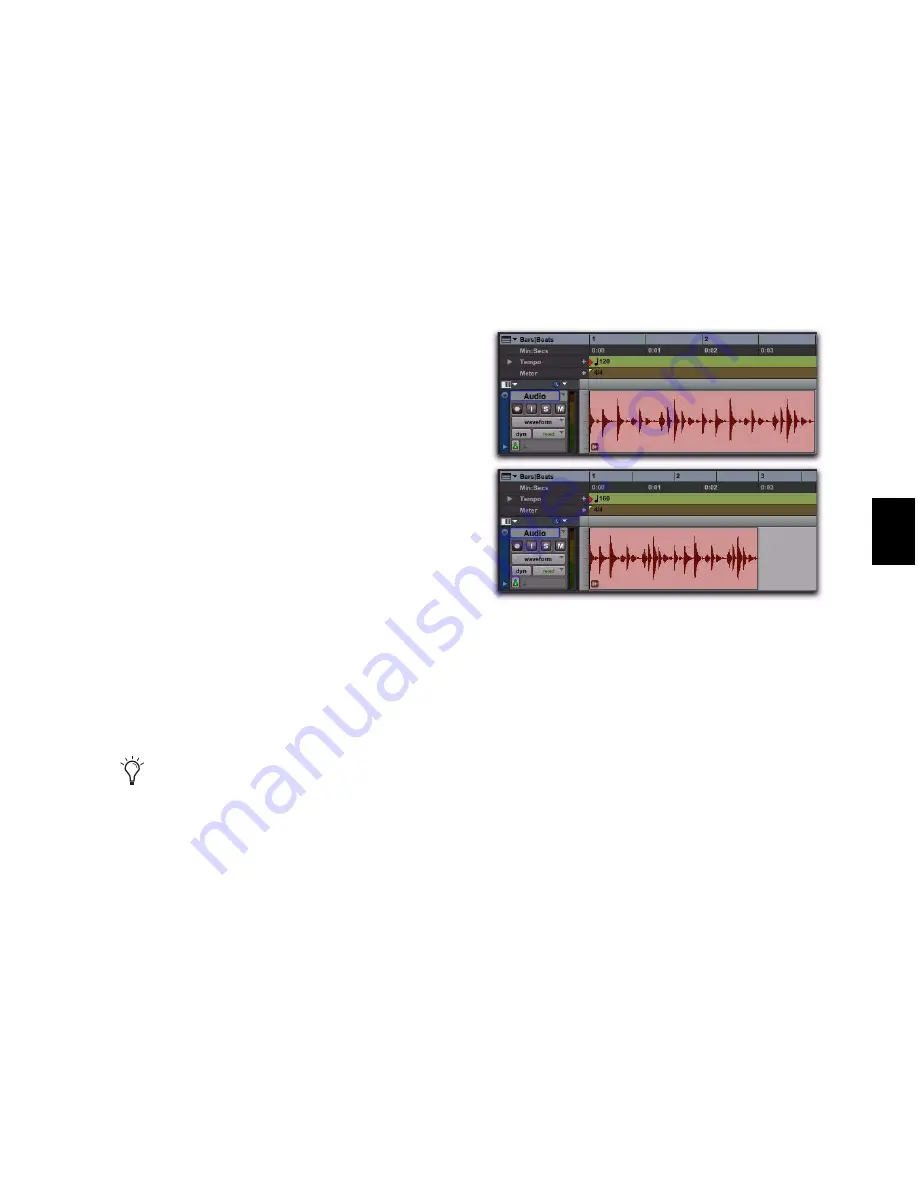
Chapter 36: Region Loops and Groups
747
A region group is separated when you do any of
the following:
• Insert a track within a multitrack region
group.
• Move a track that is part of a multitrack region
group so that it is no longer adjacent with the
other tracks of the region group.
• Hide a track that is part of a multitrack region
group.
• Delete a track that is part of a multitrack re-
gion group.
• Change the tempo of a mixed sample-based
and tick-based region group.
• Record into a region group.
• Change playlists on a track that is part of a
multitrack region group.
• Change to Playlists view.
• Apply manual warping in Warp view.
There may be situations where you want sepa-
rated region groups. For example, if you use the
same accompaniment on verses one and two of
a song, you can group the parts of verse one and
copy them as a region group for verse two, but
still have a continuous vocal track in the middle
of those region groups.
Region Groups on Tick-Based
Tracks
When changing tempos, region groups on tick-
based tracks adjust their length by adjusting the
position of all enclosed regions accordingly.
This can be useful for arranging rhythmic mate-
rial and for playing back region groups imported
from REX and ACID files.
Changing Region Group Timebase
The timebase format of a region group can be
changed by:
• Changing the track’s timebase.
– or –
• Dragging the region group to a track with a
different timebase.
Changing the timebase creates a copy of the
original region group. Both region groups (the
original and the copy) appear in the Region List,
but they have different timebases.
If you want to delete a track and keep the
region group intact, first ungroup the region
group, then delete track, and then Regroup
the region group. The region group will be
recreated intact, but without the deleted
track.
A region group on a tick-based audio track at 120 BPM
and at 160 BPM
Summary of Contents for Digidesign Pro Tools 8.0
Page 1: ...Reference Guide Pro Tools 8 0 ...
Page 18: ...Pro Tools Reference Guide xviii ...
Page 19: ...1 Part I Introduction ...
Page 20: ...2 ...
Page 24: ...Pro Tools Reference Guide 6 ...
Page 40: ...Pro Tools Reference Guide 22 ...
Page 45: ...27 Part II System Configuration ...
Page 46: ...28 ...
Page 58: ...Pro Tools Reference Guide 40 ...
Page 76: ...Pro Tools Reference Guide 58 ...
Page 118: ...Pro Tools Reference Guide 100 ...
Page 127: ...109 Part III Sessions Tracks ...
Page 128: ...110 ...
Page 144: ...Pro Tools Reference Guide 126 ...
Page 170: ...Pro Tools Reference Guide 152 ...
Page 228: ...Pro Tools Reference Guide 210 ...
Page 292: ...Pro Tools Reference Guide 274 ...
Page 343: ...325 Part IV Playback and Recording ...
Page 344: ...326 ...
Page 386: ...Pro Tools Reference Guide 368 ...
Page 442: ...Pro Tools Reference Guide 424 ...
Page 443: ...425 Part V Editing ...
Page 444: ...426 ...
Page 490: ...Pro Tools Reference Guide 472 ...
Page 528: ...Pro Tools Reference Guide 510 ...
Page 566: ...Pro Tools Reference Guide 548 ...
Page 590: ...Pro Tools Reference Guide 572 ...
Page 591: ...573 Part VI MIDI ...
Page 592: ...574 ...
Page 648: ...Pro Tools Reference Guide 630 ...
Page 670: ...Pro Tools Reference Guide 652 ...
Page 679: ...661 Part VII Arranging ...
Page 680: ...662 ...
Page 756: ...Pro Tools Reference Guide 738 ...
Page 769: ...751 Part VIII Processing ...
Page 770: ...752 ...
Page 780: ...Pro Tools Reference Guide 762 ...
Page 786: ...Pro Tools Reference Guide 768 Figure 3 Quantized audio events Warp markers in Warp view ...
Page 814: ...Pro Tools Reference Guide 796 ...
Page 842: ...Pro Tools Reference Guide 824 ...
Page 843: ...825 Part IX Mixing ...
Page 844: ...826 ...
Page 976: ...Pro Tools Reference Guide 958 ...
Page 991: ...973 Part X Surround ...
Page 992: ...974 ...
Page 1000: ...Pro Tools Reference Guide 982 ...
Page 1025: ...1007 Part XI Sync and Video ...
Page 1026: ...1008 ...
Page 1080: ...Pro Tools Reference Guide 1062 ...
Page 1111: ......
















































